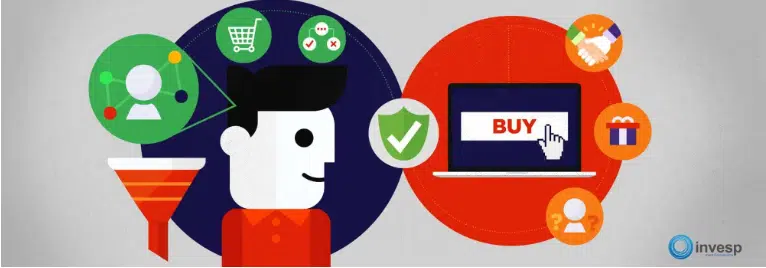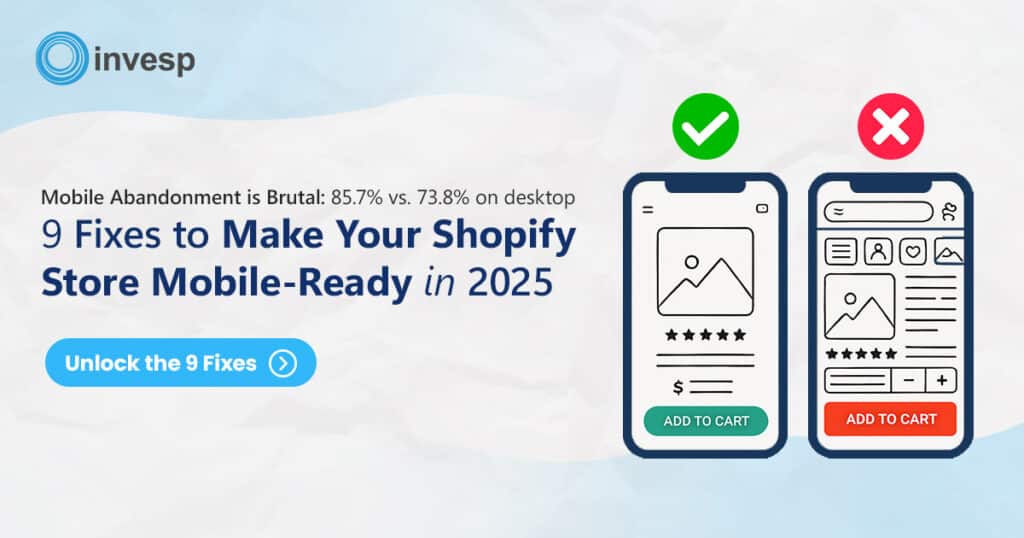In 2025, the best SaaS value proposition isn’t just live on your homepage. It shows up in Google results, in ChatGPT summaries, and even in AI-powered product comparisons before a prospect ever visits your site.
That means your messaging has to work harder and faster than ever. It needs to:
-
Grab attention in seconds
-
Communicate the core benefit in plain language
-
Differentiate yourself from dozens of similar tools in your category
-
Be clear enough for both humans and machines to understand
The main reason prospects don’t convert? They can’t clearly see the value you offer or how it applies to their needs. That’s why the best SaaS value propositions in 2025 are concise, benefit-led, and tuned for today’s multi-channel discovery process.
We’ve analyzed some of the best SaaS value proposition examples for 2025. You’ll see why these value propositions work in 2025, and how you can apply the same principles to your own.
What Is a SaaS Value Proposition (and What It Should Include)
A SaaS value proposition is a concise statement that explains what your software does, who it is for, and the main benefit it delivers, making it stand out from competitors.
It’s often the first thing potential customers see, whether on your homepage, in a Google search result, or in an AI-generated product summary. If your value proposition isn’t specific and benefit-driven, people won’t understand why your product matters to them.
In 2025, this statement needs to work across multiple discovery channels: it must capture attention on your website, be clear enough for AI assistants to summarize accurately, and resonate with buyers comparing tools side-by-side.
Here are the essential elements every strong value proposition should include:
- Headline: Your first point of contact. It should tell visitors what your SaaS business does and signal that you understand their priorities. Build trust by being specific and credible—for example, naming the audience (“for global teams”) or quantifying results (“used by 10,000+ designers”).
- Sub-headline: Adds clarity by stating what you offer (e.g., “project management software”), who it’s for (e.g., “remote teams, agencies, and startups”), and the primary benefit (e.g., “to plan, track, and deliver work on time”). This makes it easier for visitors to quickly decide if the product matches their needs and to picture themselves using it.
- Visuals: A screenshot, GIF, or video that shows your product in action, making the promise concrete. The visual should echo the headline and sub-headline—for instance, showing the exact feature or result you’ve just promised rather than compete by introducing unrelated features or distracting animations that pull attention away from the core message.
In short: Headline, sub-headline, and visual are the three non-negotiables of any effective value proposition. Ensure they work together, focus on the main customer benefit, and align with your overall goal of getting them to sign up or make a purchase.
Top SaaS Value Proposition Examples 2025
Here are some of the best value proposition examples that work in the AI era. That means brands whose value props are winning clicks, sign-ups, and AI citations alike.
1. Notion
Headline: The AI workspace that works for you.
Sub-headline: One place where teams find every answer, automate the busywork, and get projects done.
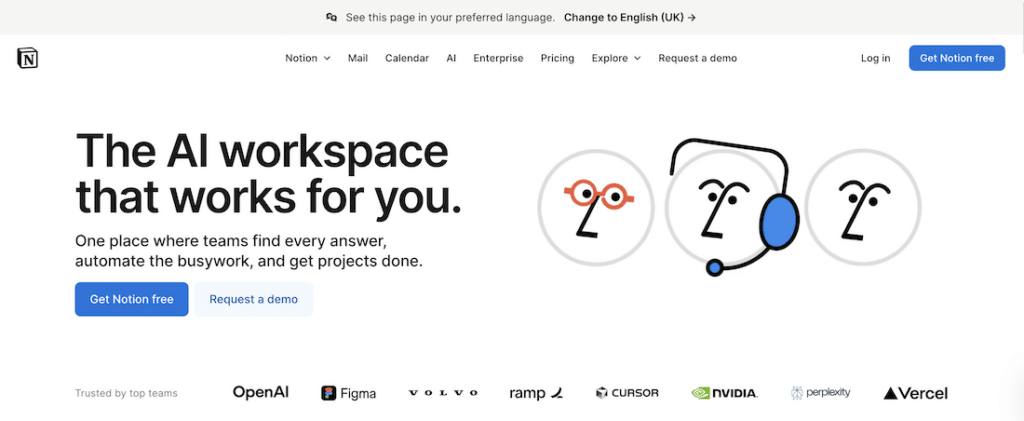
Notion positions itself as a unified workspace that integrates AI directly into knowledge management and project workflows. The headline is short, benefit-led, and instantly differentiates the product from traditional productivity tools by centering AI as the enabler.
The sub-headline expands on the promise: one platform for finding information, automating repetitive tasks, and completing projects. They basically address all core pain points for modern teams.
Their inclusion of trusted brand logos like OpenAI, Figma, NVIDIA, and Perplexity serves as adequate social proof, reinforcing credibility in the AI era.
Why it works in 2025:
- AI-first positioning: Clearly defines the product as an AI-powered workspace.
- Outcome-focused: Emphasizes results (finding answers, automating work, completing projects) over features.
- Clarity for multiple audiences: Relevant to startups, enterprises, and distributed teams alike.
- Trust signals: High-profile customer logos validate authority and adoption.
2. Motion
Headline: Create Hundreds of AI Employees Inside Motion’s Work Management Platform
Sub-headline: Manage all human work and AI work in a single platform with seamless handoff.

Motion’s value proposition works because it pairs a bold promise with immediate clarity. The headline reframes “AI tools” as “AI employees,” an instantly relatable concept that makes people think about delegation, capacity, and scaling without extra hires, positioning Motion as a digital workforce, not just software.
The subheadline grounds this idea by showing the scope: uniting human and AI workflows in one platform for seamless handoffs, eliminating the friction of juggling multiple tools.
Supporting visuals make the benefits tangible by listing specific, high-frequency tasks like “Draft Emails,” “Take Meeting Notes,” and “Create Schedule,” so visitors can connect the product to their daily work instantly.
Plus, they reinforce the trust early with the “#1 hottest product” badge from Amplitude, placed above the headline. This signals to first-time visitors that Motion is not an untested newcomer, but a product already validated by others.
Why it works in 2025:
-
Specific + scalable benefit: “Hundreds of AI employees” is more compelling than “automation tools.” It suggests speed, capacity, and growth.
-
Grounded in real use cases: Lists actual tasks AI can do, so the value isn’t abstract.
-
Dual-layer messaging: Big, aspirational hook followed by a clarifying subheadline.
-
Trust signal upfront: Recognition badge earns credibility before the pitch.
-
Choice of actions: “Try for free” and “Contact sales” cater to both quick adopters and enterprise buyers.
3. Hubstaff
Headline: Time tracking software for the global workforce
(with “global” rotating to “modern” and “hybrid” dynamically on the homepage)
Sub-headline: Integrated time tracking, productivity metrics, and payroll for your distributed team.
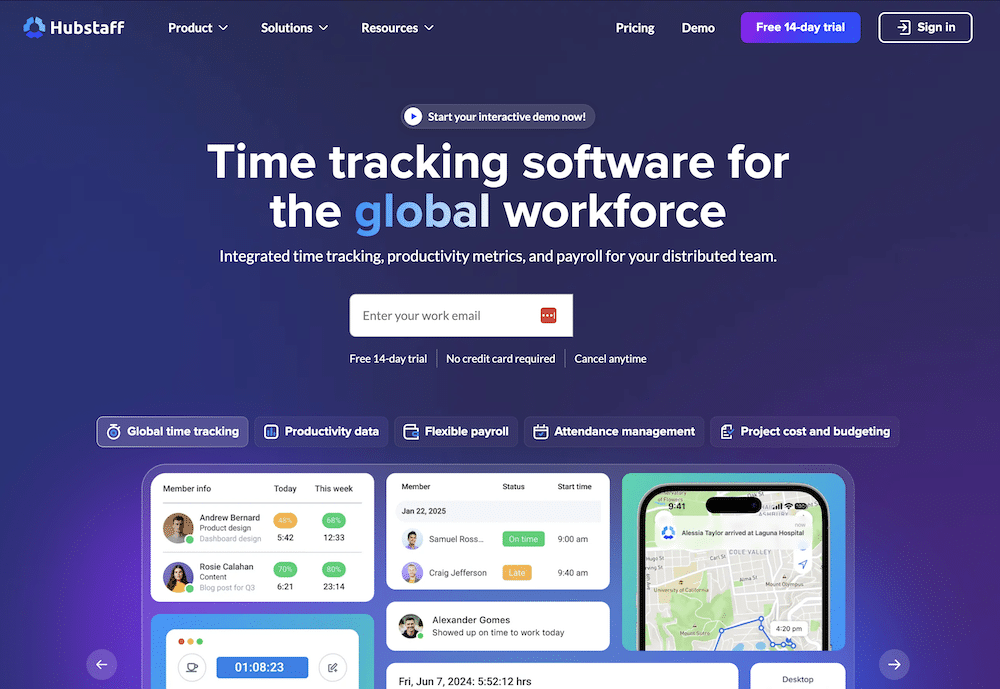
Hubstaff is an all-in-one platform for managing field and remote teams. The rotating keyword (“global,” “modern,” “hybrid”) personalizes the headline for different audiences, from international teams to modern offices to hybrid workplaces.
The sub-headline clarifies that Hubstaff is more than a timer: it’s a complete system for productivity analytics, payroll, and team management. Paired with clickable feature tabs (“Global time tracking,” “Productivity data,” “Flexible payroll,” “Attendance management,” “Project cost and budgeting”), visitors instantly see its full scope.
Why it works in 2025:
-
Adaptive messaging: Rotating descriptors personalize the pitch based on audience needs.
-
Clear problem-solving: Integrates time tracking with payroll and productivity, addressing multiple pain points in one tool.
-
AI-friendly phrasing: Short, benefit-driven language that search engines and AI tools can parse easily.
-
Global relevance: Appeals to remote, hybrid, and international teams.
4. Asana
Headline: Where your teams and AI coordinate work together
Sub-headline: See how your work connects to goals while working alongside AI that understands your business.

Asana’s value prop works because it explains exactly what’s different about it: your team and AI don’t just sit in the same tool, they work together.
The subheadline gets specific: the AI links the small things you do each day to the big goals you’re trying to hit. That matters because most AI tools can help you finish a task (write an email, take meeting notes, make a spreadsheet), but they don’t check if it’s helping you reach the things that really matter, like launching a product on time, hitting a sales target, or improving retention.
The homepage backs this up with a simple example: Asana AI drafts a brief, your teammate approves it, and the task gets assigned. This makes it easy to picture how it could cut down on back-and-forth and keep projects moving.
Why it works in 2025:
-
Spells out the role of AI: Not a separate feature but a teammate that helps with coordination.
-
Ties tasks to outcomes: Ensures work aligns with company goals, not just “gets done.”
-
Shows it in action: Uses a common scenario to make the benefit easy to understand.
-
Clear next steps: “Get started” and “See how it works” provide both quick movers and cautious testers with a clear path forward.
5. Clueso
Headline: Product videos in minutes with AI
Subheadline: Transform raw screen recordings into stunning videos & documentation.
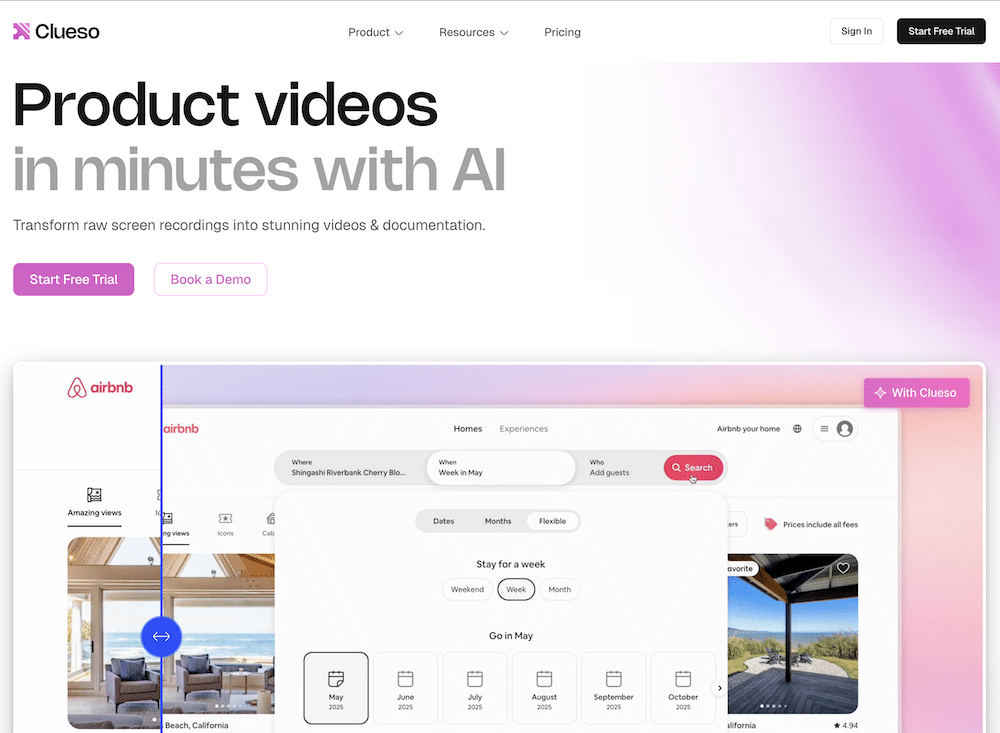
Clueso’s value proposition works because it makes three things obvious within seconds:
- The output — you get “product videos.”
- The speed — “in minutes.”
- The edge — powered by AI.
That’s all the essential information a visitor needs to decide if it’s worth exploring further. The subheadline then adds a practical detail (“videos & documentation”), showing it’s not just one deliverable, but two, giving the promise more weight.
The visual reinforces this clarity by showing an actual before-and-after of a screen recording being transformed.
Why it works in 2025:
-
Clear deliverable: No jargon—it says exactly what you get.
-
Time-focused hook: “In minutes” signals efficiency without overpromising.
-
Visual proof: Real UI examples show the result, not just tell.
-
Double output: Video + documentation in one pass makes it a multi-win tool.
6. Partner Fleet
Headline: We make it way easier to build your app marketplace
Sub-headline: It used to require deep pockets and a year of development to build a marketplace. Now it takes weeks, no code needed.

Partner Fleet’s value proposition addresses two key concerns every B2B buyer cares about: saving money and saving time. The headline is casual and approachable (“way easier”) but still clear about the outcome, i.e., building an app marketplace. No fancy jargon, just a direct promise.
The follow-up line locks in the credibility: building this kind of marketplace used to be expensive and slow, but now it’s fast and code-free. That “old way vs. new way” framing works because it instantly shows the transformation. Even if you’ve never built a marketplace before, you understand the advantage.
The visual seals the promise with logos from brands like Salesforce, Google, HubSpot, and Shopify, so you’re not just told what you could build, you can picture it.
Why it works in 2025:
-
Everyday language: Talks to you like a person, not a spec sheet.
-
Before/after framing: Shows the transformation from expensive/slow to fast/accessible.
-
Concrete mental image: Well-known brand logos help the value click faster.
-
No wasted clicks: “Get started” keeps the next step simple.
7. Webflow
Headline: Turn traffic into revenue
Sub-headline: With Webflow’s all-in-one platform, you can create, manage, and optimize web experiences that convert — without sacrificing brand consistency.
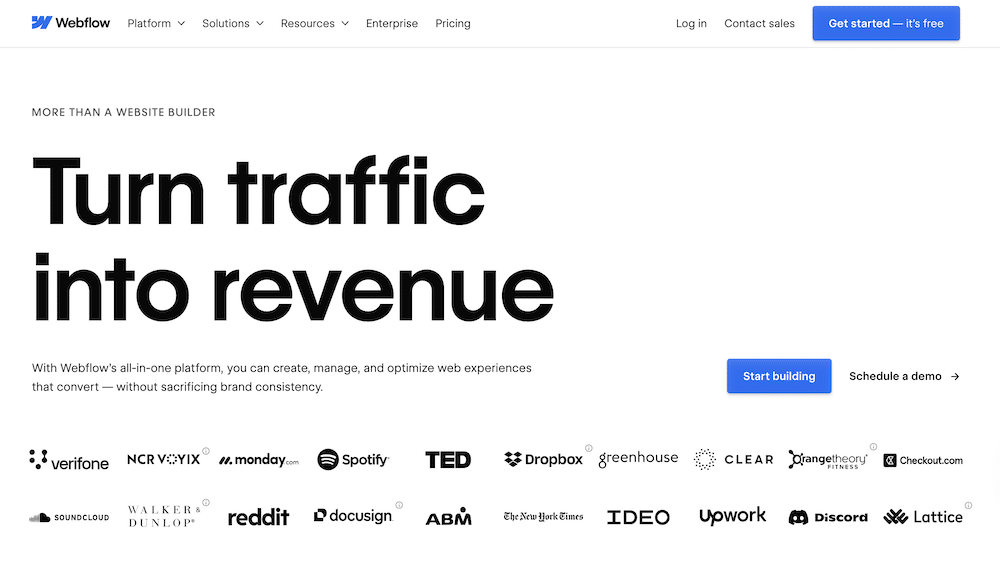
Webflow has shifted its positioning from “no-code website building” to a conversion-focused growth platform. The new headline speaks directly to the business impact that involves transforming visitors into paying loyal customers, which resonates with the revenue-driven priorities of 2025 SaaS buyers.
The sub-headline still hints at their original strengths (ease of creation, brand control) while broadening their appeal beyond marketers who want no-code tools to growth teams focused on ROI. Partner logos from brands like Spotify, TED, and The New York Times reinforce authority.
Why it works in 2025:
- Outcome-oriented: Focuses on the end goal (revenue) rather than the process (building websites).
- Broader audience reach: Appeals to both marketers and business decision-makers.
- Retains core differentiators: All-in-one, brand-consistent web creation without code.
- Credibility through social proof: Recognizable customer logos validate the promise.
8. ProofHub
Headline: The one place for all your projects, teams and communications
Sub-headline: ProofHub is the project management and team collaboration software designed for teams of all sizes. It helps you save time, stay focused, and increase productivity, making meeting deadlines a breeze.
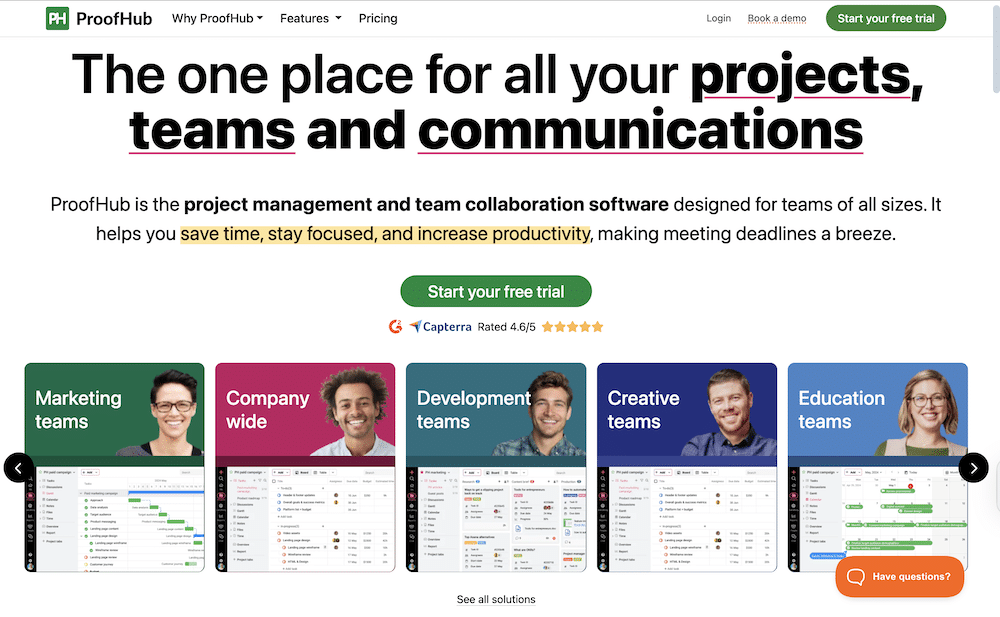
ProofHub’s value prop isn’t flashy, and that’s exactly why it works. It tells you what it is (project management and collaboration software), who it’s for (teams of all sizes), and the core benefits you can expect (saving time, staying focused, increasing productivity).
The homepage reinforces this with examples for different team types, including marketing, development, creative, and education, each paired with a product screenshot. Target customers also see the social proof placed directly under the primary CTA with a 4.6/5 Capterra rating, helping build trust right when visitors are still deciding whether to try it.
As Vartika Kashyap, CMO at ProofHub, explains:
“A clear value proposition is shaped by your market position, core USP, and the exact pain point you’re addressing. In our internal experiments, we’ve found that direct, educational copy performs better than catchy slogans.”
Why it works in 2025:
-
Clear and direct: Explains exactly what it is and what it does without jargon.
-
Universal benefits: Focuses on outcomes that matter to any team.
-
Visual versatility: Shows how it works for multiple team types.
-
Trust upfront: Strong Capterra rating placed near the CTA builds credibility.
-
Low-friction CTA: “Start your free trial” is clear and actionable.
9. CleanShot X
Headline: Capture your Mac’s screen like a pro.
Sub-headline: (No sub-headline — the headline alone communicates the offer.)
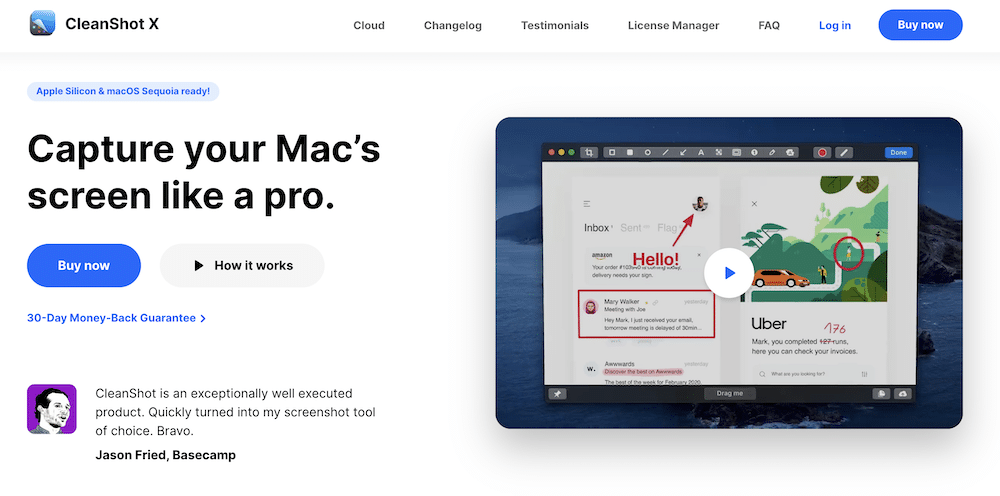
If you weren’t aware, you have 5 to 30 seconds to hold your visitors’ attention.
And your value proposition is the first thing customers will see. That’s why it’s essential to develop a value proposition that makes your business stand out in the market, relays all the benefits of your products, and is succinct at the same time.
CleanShot’s value proposition ticks all the boxes.
It’s only seven words long. And as soon as you land on their homepage, you know:
- What the brand does (capture Mac’s screen)
- Who their target audience is (MacBook users)
- What makes them different from their counterparts (the ability to take screenshots like a professional)
The combination of the video demonstrating the product’s benefits in action and a high-profile testimonial from Jason Fried (Basecamp) makes for a near-perfect value proposition. Plus, the clear “Buy now” and “How it works” CTAs make it easy to take the next step immediately.
Why it works in 2025:
-
Clear and concise: Seven words communicate the product, audience, and benefit.
-
Instant proof: Hero video shows exactly how the product delivers.
-
Social validation: A Recognizable testimonial adds trust and authority.
-
Direct CTA: Easy path to purchase or learn more.
-
Audience-specific: Speaks directly to Mac users, making it highly relevant.
10. Hex
Headline: Go deeper than dashboards
Sub-headline: Hex is the AI-powered analytics workspace built for teams driving faster answers and better decisions.

In just six words, Hex’s value proposition clearly tells you what makes them different: they’re not another dashboard tool. The sub-headline makes that clear by explaining exactly what they are: an AI-powered analytics workspace built to help teams move faster and make better decisions. It shifts the focus from static reporting to active exploration, analysis, and decision-making.
The hero section supports this with a short, looping video demonstrating the product’s capabilities, from data querying to result visualization and interactive report sharing.
Right below, they add logos from well-known customers like Anthropic, Notion, and Loom, along with a clear “Get started” and “Request a demo” CTA, giving visitors both trust and an immediate next step.
Why it works in 2025:
-
Direct differentiation: The headline rejects the generic dashboard category.
-
Sub-headline clarity: Explains exactly what Hex is and the value it delivers.
-
Outcome-led: Ties AI to clear benefits (faster answers and better decisions).
-
Proof in action: The hero video shows the product delivering on its promise.
-
Social validation: Recognizable customer logos build credibility.
-
Low barrier to try: Simple CTA encourages immediate sign-up.
11. ClickUp
Headline: Replace all your apps and get 400% more done.
Sub-headline: One AI Workspace for projects, knowledge, chat, and more.
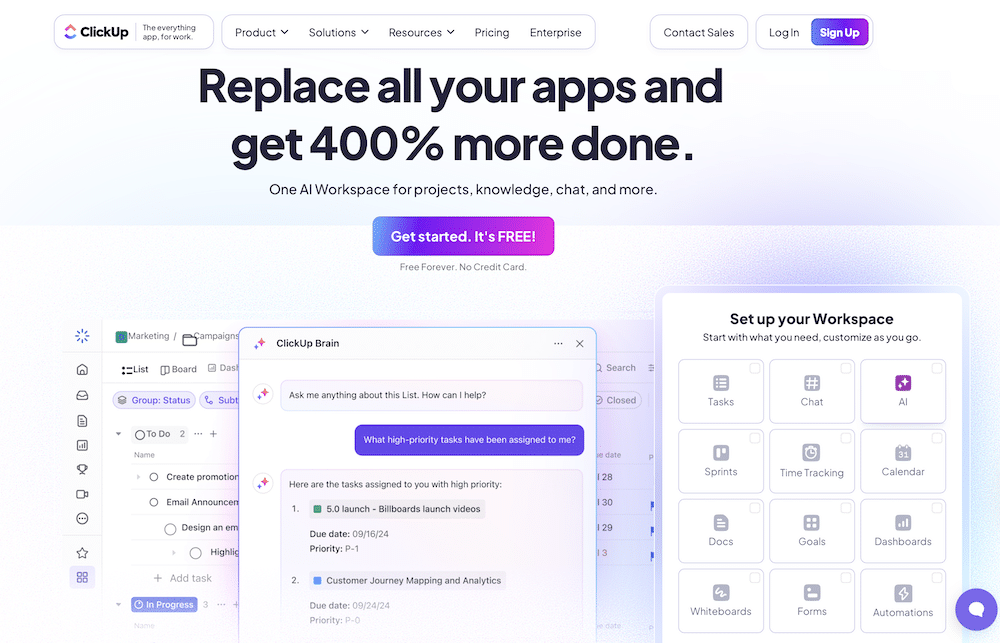
ClickUp’s value proposition used to focus on replacing multiple tools. Now it also tells you how much more work you can get done and puts a number on it: 400%. That shift makes the benefit clear and measurable.
The “AI Workspace” part in the sub-header tells you it’s not just a task list. It’s a place to manage projects, store knowledge, chat with your team, and utilize AI to accelerate your work.
It doesn’t get better than that. But in ClickUp’s case, it does. They double down with a visual depiction of their workspace, showing its visual interface and exactly how it works.
Why it works in 2025:
-
Specific benefit: The “400% more done” claim gives a clear, measurable outcome.
-
AI as a core feature: Positions AI as part of the main workspace, not an add-on.
-
Tool consolidation: Solves the “too many apps” problem while expanding capabilities.
-
Proof on the page: Shows real product screenshots, so the claim feels believable.
Ready to Write Your Perfect SaaS Value Proposition?
Hopefully, these examples will give you some nuts and bolts to create your own strong SaaS value proposition statement.
Across all these examples, the winning value propositions had a few things in common:
-
Clarity over cleverness: They tell you exactly what you get and why it matters, without drowning you in jargon.
-
Outcome-led framing: They focus on the result or transformation, not just the feature list.
-
Proof and context: They back up the claim with examples, social proof, or a quick “before vs. after” contrast so the benefit feels real.
If there’s one takeaway, it’s this: Make your value proposition so clear and compelling that someone could repeat it accurately after hearing it once. If it works for humans and is easy for AI to summarize, you’ve got messaging that can win across every channel in 2025.
And if you want help crafting a value proposition that doesn’t just sound good on your homepage, but actually converts across search, AI results, and live sales conversations, that’s exactly what we do at Invesp. We’ve spent nearly two decades optimizing messaging for SaaS brands, turning first impressions into lasting revenue growth.

